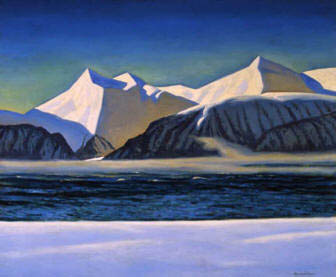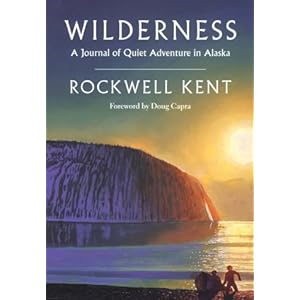 Artist Rockwell Kent seems to be everywhere I turn lately. Not only is he one of Adam's favorite artists (he sent me a postcard of some of Kent's work once), but a program about his life and work has been running and re-running on television, and he has ties to Alaska. How is it that this artist who was relatively unknown to me is suddenly omnipresent in my world?! I think it's time to learn more about him. Rockwell Kent is an American artist from the Northeast who traveled extensively and was one of the most visible artists of his time. He was also an activist who received a lot of criticism for his leftist/socialist politics. His work is very interesting and embodies much of the realist spirit, with the minimalist lines of his paintings often reminiscent of his skillful woodblock prints. I adore the clean, "athletic" nature of his lithographs - one of my favorite art forms.
Artist Rockwell Kent seems to be everywhere I turn lately. Not only is he one of Adam's favorite artists (he sent me a postcard of some of Kent's work once), but a program about his life and work has been running and re-running on television, and he has ties to Alaska. How is it that this artist who was relatively unknown to me is suddenly omnipresent in my world?! I think it's time to learn more about him. Rockwell Kent is an American artist from the Northeast who traveled extensively and was one of the most visible artists of his time. He was also an activist who received a lot of criticism for his leftist/socialist politics. His work is very interesting and embodies much of the realist spirit, with the minimalist lines of his paintings often reminiscent of his skillful woodblock prints. I adore the clean, "athletic" nature of his lithographs - one of my favorite art forms.  Some of Kent's most famous illustrations were for Herman Melville's 1930 publication of Moby Dick. Take a look at the beautiful movement and combination of strength and fragility in the illustration of the whale breaching...stunning!! Perhaps in this book you can see some of Kent's love for the sea. He spent a lot of time on Monhegan Island (Maine) where he was impressed by nature, and especially the ocean. This speaks to me, because I also have a love of the ocean and of the wilderness. In addition to the three volume edition (later compressed to one volume) of Moby Dick, Kent illustrated and wrote other books with nautical themes including A Treasury of Sea Stories edited by Gordon C. Aymar. He wrote and illustrated N by E, and Voyaging, which were about his sailing experiences. He was also influenced by the transcendentalist writings of Emerson, Thoreau and Whitman - whose works also impress and influence me...especially Whitman.
Some of Kent's most famous illustrations were for Herman Melville's 1930 publication of Moby Dick. Take a look at the beautiful movement and combination of strength and fragility in the illustration of the whale breaching...stunning!! Perhaps in this book you can see some of Kent's love for the sea. He spent a lot of time on Monhegan Island (Maine) where he was impressed by nature, and especially the ocean. This speaks to me, because I also have a love of the ocean and of the wilderness. In addition to the three volume edition (later compressed to one volume) of Moby Dick, Kent illustrated and wrote other books with nautical themes including A Treasury of Sea Stories edited by Gordon C. Aymar. He wrote and illustrated N by E, and Voyaging, which were about his sailing experiences. He was also influenced by the transcendentalist writings of Emerson, Thoreau and Whitman - whose works also impress and influence me...especially Whitman.  | |
| Twilight |
Listen to this passage from N by E : “Twilight, the ocean, eight o-clock have come; I take the helm on my watch. The wind has risen, the horizon is dark against a livid sky. It’s cold. Never again for months to come do my thoughts run to nakedness. Nor do I see green fields, nor thriving homesteads, nor people long enough except to part from them; nor—though it’s June—the summer; not for a thousand miles. And as it darkens and the stars come out, and the black sea appears unbroken everywhere save for the restless turbulence of its own plain, as the lights are extinguished in the cabin—then I am suddenly alone. And almost terror grips me for I now feel the solitude; under the keel and overhead the depths,—and me, enveloped in immensity. How strange to be here in a little boat!—and not by accident....”
Rockwell Kent also wrote about Alaska and other extreme climates that he visited - New Foundland, Greenland, Tierra del Fuego, and more... His book about Alaska is called Wilderness: A Journal of Quiet Adventure in Alaska. His imagery of the solitude and stillness of the Alaskan winter landscape is breathtaking and excites me about the beauty of the winter-to-come. In his paintings you really notice how perfectly everything is structured; the idyllic quality of the scene. They are truly lovely.
Perhaps the reason that I haven't heard as much about this Rockwell as another Rockwell (whom I love) is because of his activities outside of the art world. Rockwell Kent spent a lot of time championing social causes, supporting strikes and exhibiting left-leaning politics in a climate that was highly suspicious of such "activity". Kent was investigated by the House Un-American Activities Committee in 1939 and although he testified that he was not a member of the Communist Party the government kept a close watch on him and eventually revoked his passport in 1950. He sued for its reinstatement and won in a landmark Supreme Court case in 1958.
 | |
| Resurrection Bay, Alaska c. 1919 |
Kent's politics, viewed with a new perspective, do not seem as radical as they may have originally seemed. Kent protested the executions of Sacco and Vanzetti; during the 1930s he received many commissions from the United States government even though he was a member of the IWO; and in the 1940s he traveled in Europe to attend meetings to promote world peace. His association with Communism meant that he became very unpopular in the United States and he fell out of favor with American galleries.
He was the first American artist to have work exhibited in the Soviet Union (1957), for which he earned the Lenin Peace Prize in 1967.
 |
| Mural for the GE Pavilion at the 1939 World’s Fair, “Man’s Liberation Through Electricity.” |
Although his work lacked public support later in his life, and he eventually wrote about his "confrontations" with the United States government, some of his most striking pieces are the murals he did for various government departments. They are full of symbolism and elegance and, although for a time some were covered up, have recently been restored as significant pieces of American art and markers of the time.
I'm glad to have been introduced to this artist. Thank you Adam. Thank you Biography channel. Thank you Alaska!

That was very interesting, I had never heard of him either, that I recall...
ReplyDelete